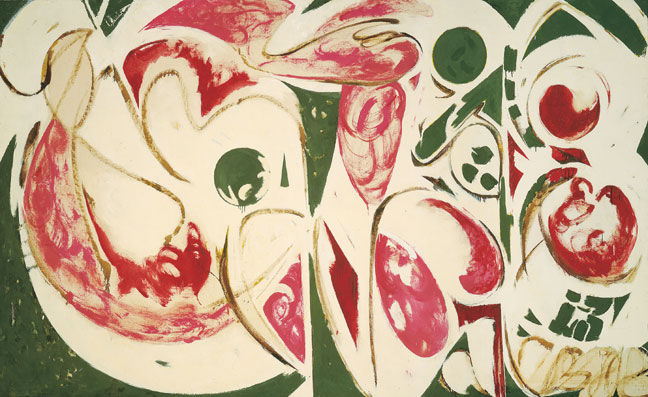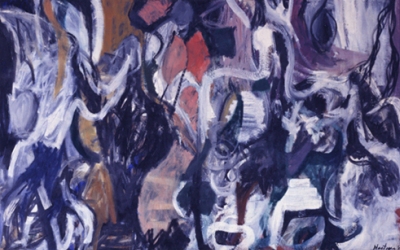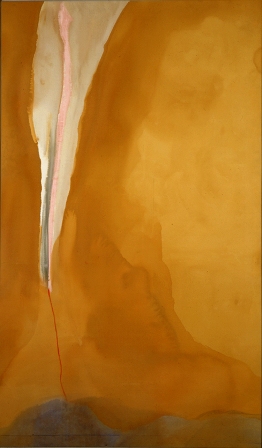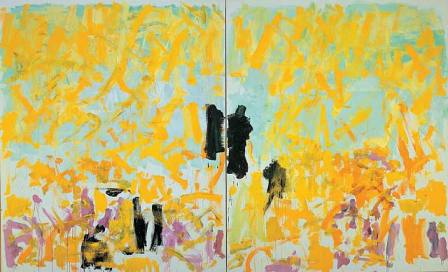
Lee Krasner, The Sun Woman II, 1958, 70 x 114 inches
I thought I’d begin my first official post with a confession.
I love abstract expressionist work. There’s very little of it that doesn’t give me enormous satisfaction.
Why do I love it?

Jane Frank, Crags and Crevices, 1961, 70 x 50 inches
It uses up all the canvas. You don’t have to decide what’s the most important element to look at. You don’t have to worry through finding the one place where the artist wants you to stare. You can start anywhere and get anywhere.

Grace Hartigan, The Massacre, 1952, oil on canvas, 81 x 130 inches
Abstract Expressionism focuses on the same things I love about art materials –the way the paint stains and piles, the texture of the support, the spilling and plopping and slooshing and combining of oil and pigment.
I love the color. Sometimes color is all that there is, perhaps a single hue, and because of the simplicity, I have to look and look and look again. I have to find the subtle changes, the minute brush hairs, the texture of the underpinnings.
I love it that it’s so physical and arm waving with whole body movement, ladder climbing, and studio visits by curators and dealers, necessitated by the sheer size of the canvases. Those artists made the curators and dealers come to them.
I love it that whatever meaning is placed upon it by the artist and/or others is often beside the point. I love it because while much of it purports to have schemes and notions, not many of those notions can be sketched out ahead of time. What arises, arises from the work and the materials themselves.

Helen Frankenthaler, Coral Wedge,1972, acrylic on canvas, 81 1/2 x 46 1/2 inches,
I love it that there are lots and lots of women doing art as good as the men, not perhaps getting the same kind of cultural adoration, and, I suspect, rolling their eyes over the hyper-masculine antics of their colleagues. But there they are, holding their own.
Wikipedia has a decent run-down of the movement, which basically ran from post-WWII through 1960 and involved all the old guys we know about — Jackson Pollock, Mark Rothko, Willem de Kooning. It also involved the same number of women, some of whom we might know of — Helen Frankenthaler, Louise Bourgeois, Joan Mitchell — but many of whom are still to be revealed in their fullest glory. Oh joy, all that art for me to discover and absorb.
Joan Mitchell Cypress, 1980,
oil on canvas 260 x 360 inches
The art we love (as perhaps different from admire or emulate) is a matter first and foremost a personal emotion. I love abstract expressionism because my father, a welder and visually illiterate man, is an exemplar for me of the openness and breadth of the Ab Ex art. I love abstract expressionism because the territory I grew up in had its wide open visuals, fields bordered by black rivers, views across blued hills, textures coated by mud or foliage. I love it because it refuses my own ego, takes me out of myself, makes me a giant eyeball. I love it because it isn’t about something I can name.
Which brings me to the requisite Art and Perception conclusion — the question. What piece of art, artist, or art movement brings you joy at this moment or on a recurring basis?


June,
I like abstraction with meaning. For some reason I need to find meaning or messages in artwork and feel frustrated when I do not find it. Sometimes I try and discern meanings out of the forms but rarely succeed as I fail to find resonance in my interpretations.
I like meaningful abstraction. Unfortunately I do not have a roster of artists that engage in meaningful abstraction but I am still searching.
I think impressionism and cubism marked some of the beginnings of meaningful abstraction. In my view, a strong movement was lacking in the 20’s that could take the principles generated out of impressionism and develop more avenues for meaningful abstraction.
Artists like Pollock and de Kooning twisted the concept orthogonally somewhat.
All this being said, I am still trying to figure out why I like Pollock’s work for some reason…
I love the color and size and movement of AB Ex as well; for me it looks like nature — big, alive, energized, seemingly chaotic but with an underlying order, and interesting wherever I look!
Sunil,
Like you, I used to want my abstraction with meaning. And I think there’s quite a bit of that kind of abstraction floating about. Even some of the Ab Exs (I’m thinking of Elaine de Kooning and Grace Hartigan) often threw in some visuals that could be interpreted more readily.
But the more I have gotten immersed in the ab exs, the more I like them just because — well, because they are there.
As for Pollock — when I was re-viewing the ab ex stuff in general, I found that no one comes close to matching Pollock in style. One would think that it should be easy to do, but au contraire. He is sui generis (to mix my language phrasings).
What a fine post, June.
I cannot help but feel your joy. You really put that across.
I went through an AE period. I was about 22, and the phase lasted only a year. At the time I was pretty gaga over Franz Kline. In trying to understand him, I got into Japanese calligraphy for it seemed that what he was doing was just big calligraphy. My work is still informed by that study, but in the end, I found that while I could take great pleasure in the work of others, there was, for me, little joy of creation in purely abstract art.
When faced with all those same dreary questions about eschewing realism, I used to say things like, “What’s so great about reality?” And, “Why do you need so much reassurance?”
AE requires that the viewer give something and bring something to the art, and that is a great lesson. It is one of the profoundest truths of art, and it is a lesson I’ve never forgotten.
To answer your question though, the kind of art that brings me true joy is art that shows humans in a beautiful way. I’m not talking about physical beauty, necessarily. For example, there is Rembrandt’s portrait of Jan Six who was by no means a pretty man, yet his dignity, thoughtfulness, and intense creative energy shine out from the painting. Then there are those lovely Botticelli angels in which the divine nature of our spirits are expressed in ways that are physically beautiful.
I am a humanist after all. I am not in accord with theories of life which conclude we are just pieces of animated meat, and I take joy in art which portrays us in ways that glorify our better nature.
Naturally, like the Renaissance artist, I see Attic art as the Mother of the World, for there, in one brief period, came revolutions in life, philosophy, and politics that have never since let any tyrant sleep easily. In modern times, there have been many artists who continued the humanist tradition, like Maxfield Parrish or even Andrew Wyeth though the latter rather tends to see us as just hanging on to our self worth in a conflicted world. Then too, there is the heroic idealism of superhero comics, and to say that these things don’t bring me joy would be a big fat lie, because they do. I really wish I could be as good a person as Superman.
As a portraitist, it was often commented that I definitely saw the good in people and put that in the painting. There you have it. My supreme joy.
Thanks, Rex, for the thoughtful (and complimentary) comment:
After reading your comment, I started thinking about portraits and I realized one of my favorites is of Rembrandt’s “Hendrickje Bathing” (1655).
That probably points out as clear a comparison between our individual aesthetic delights as can be — heroic idealism versus golden hedonism.
But I too would like to be as heroic as Superman. Some daydreams never fade.
What piece of art, artist, or art movement brings you joy at this moment or on a recurring basis?
That is a good question, June. I pondered it for a moment, thinking of various artists and works. Then the answer came to me all of a sudden. The art that brings me joy, at this moment and on a recurring, basis is my own.
ah, Karl, you are onto something.
After I asked the question, I decided that it was a pretty foolish one — it’s like asking which food or color is your favorite — why would anyone bother to choose among the delights?
And generally speaking, with variations allowed for the time of day, the amount of coffee, and the state of the canvas/design wall/stitching — I too would have to say that “The art that brings me joy, at this moment and on a recurring basis is my own.”
How terrible if it weren’t so. I suppose some people are driven by demons and so the doing the art is the only repose they get — which isn’t the same as joy. But for me, joy is the word.
June:
The bigger the gesture, the more of the person absorbed.
To me at least, Ab Ex is a hard chew and you bit off a fair piece of it.
I wonder to what degree our pleasure in seeing a Pollock, say, would compare with his pleasure in making it. There was a certain betting the farm quality to the work of this troubled man. And what might register to me as a vibrant and engaging painting might have been for him a temporary release from some bedevilment, leading then to yet another battle with high personal stakes.
Congrats on an essay well done.
Jay
Jay,
You are possibly right about Pollock — the documentary on him shows him as a man going about his work, somewhat grimly. I misread your second sentence (“betting the farm”) and was thinking that in fact the documentary showed him somewhat like a grim farmer….
Like many of the male (and possibly female) ab exs, I don’t think he was a particularly pleasant fellow and so I avoid biography in favor of personal pleasure. Biography is for teachers; viewing art is for hedonists.
June,
in my comments a few days ago that did not take, I tried to provide links to my favorite paintings in NYC, a pink Pollock in the MOMA, and in the Met, a Van Gogh called something like first steps and a Breughel showing a harvest scene.
Birgit,
I’ll look these up. I have a knee-bending weakness for Van Gogh (it’s sort of embarrassing, how long I can stand in front of his paintings.)
I am not surprised at the comments citing the need to first figure out the meaning before being able to enjoy. Abstract Expressionism is first and foremost experiential and then meaningful. I acknowledge that art without meaning is just decoration but our Western need to “get it” before we can let go and enjoy the experience is a hindrance. Enjoy first the art you love. The “meaning” will come in time.
A truly wonderful woman artist of the New York School and Abstract Expressionist group in the 50s is Constance (Connie) Whidden. She seems to have been forgotten by history but her work was first rate.
question, i recently came across 2 paintings from an artist named constance whidden, dated 1957 which are titled central park. any info?
My own art brings me the most satisfaction and joy. I am thankful that abstract expressionism is understood by so many people. However, I find it difficult to be silent when I hear people critisize the genre as though they have the higher understanding, yet they seem to always comment about how they don’t know why, but they like a certain AB Ex artist or work. This only evidences that they don’t fully understand themselves or the nature of the most “alive” artform on canvas.
The name Pollock has been mentioned several times here and I think I would like to share a few of my observations regarding his #1 1949 while they are still in my mind as I studied it “up close and personal” two days ago. Before I do though, I think I should give my perspective regarding AB Ex. What you see on the canvas is the manifestation of the artist’s intellect, spirit and soul,i.e., the unseen elements of our being transformed into a tangible three dimensional material. The work is interactive with the veiwer and invites a silent communication between the veiwer and work in a somewhat telepathic sense as the work is an emotional extension of it’s originator. Thus, the work is alive, and interactive.
This brings me to the Pollock. The approximate 5′ x 10′ work is much darker than what appears at first glance. If you view the work from a distance of less than around 20′ than you may not absorb the entire depth of the work. I found that the work is best veiwed from around 26′ at which point the blacks and blues within the deepest pool of the painting are overlaid with a thin white overlapping strand of white suggests a symphony of hope, signifying the order. Most everything else is the chaos within. It became apparent that the work was struggling to breathe, which parralells Pollock in a sense that his work wasn’t exactly sweeping the scene at the time. I say “symphony of hope” because the artist persevered.
One of the most significant elements to the work was the absence of red with the exception of that which was absorbed in the canvas and not predominent unless veiwed very closely, AND……………………
an approximate 8′ drip of blood red, virtually untainted and the only red visible from the 26′ distance. Not only is this the only element of red, but it’s position on the work was, get this, in the center. I do believe the color and placement was diliberate indeed.
Does Abstract Expressionism has a colorful future? Can you spell Kalydascope?
Brad:
I don’t follow the Kalydascope reference. Could you expand on that?
Fortunately, the future of Abstract Expressionism doesn’t depend on anyone’s spelling. :-) However, the future may not be so bright, according to Laurie Fendrich, the best speller/writer I know of at the moment among abstract artists. She writes on Brainstorm of the Chronicle of Higher Education, and has several essays on her own web site. She cares not only about A for Abstraction, but also B for Beauty. Here’s a semi-random quote from a recent interview:
Steve:
Took a little time to look in on Laurie Fendrich and I must thank you for bringing her to our attention.
Re: the Kalydascope thing. I, like the rest of us, go into Google mode when such a term comes up. And, presto, Kalydascopes abound. Take the term for a misspelling or follow the Google string in search for an insight?
Google was definitely the way to go, but I got no further than you did. Though “Kalydascope” might have been intended, there were plenty of other variant spellings–not that I regard spelling per se as important.
The kalydascope sentence I wrote was simply to express that I believe Abstract Expressionism has a very colorful future,literally, at least in my studio. :) I really did enjoy Laurie Fendrich read and I interpret it to be quite positive. For some reason there seems to be a force of people who would like to contain AB Ex to a few deceased artist and a certain short era, thus capping it off so it doesn’t flourish. I believe Laurie to be correct regarding beauty. It is the beauty and strong emotion attached to the genre that will determine it’s future. The main influences of the genre did have darks sides all, as most of us do. However, I believe the next wave a abstract pioneers will continue a new evolution to abstract expressionism, even furthuring it’s advance and increasing its portion of the “art world”. I do believe that the future of the genre also will depend on our, abstract artists’, ability to defend our thoughts and purpose in the art arena as it is apparent that attacks on our work are not going to sieze anytime soon.What are your thoughts?
Brad,
I agree about the beauty aspect, and one of the things I found most interesting in Fendrich’s writings and interviews was her explication of how it comes in to abstract painting. But she is not so optimistic in some of her writings or in this interview:
However, I don’t think it necessarily matters if the general “art world” turns toward beauty or toward abstraction; I’m sure there will always be excellent artists working that way, and buyers looking for them.
Apparently, you only like AbEx by female artists.